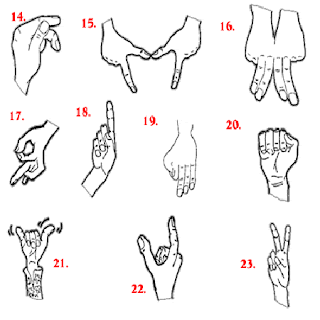Hand gestures are a ubiquitous form of nonverbal communication, woven deeply into the fabric of human interaction. From a simple wave hello to intricate sign language, our hands convey volumes, often without us even realizing it. However, the meaning ascribed to specific hand gestures can vary drastically across cultures, leading to misinterpretations and unintended consequences. Understanding the power and potential pitfalls of hand gestures is crucial in our increasingly interconnected world.
Consider the peace sign, a widely recognized symbol of goodwill and harmony. While its positive connotation holds true in many cultures, in others, it can be misconstrued as an offensive gesture. Similarly, a thumbs-up, often used to express approval or agreement, can carry a negative or even vulgar meaning in certain parts of the world. These examples highlight the importance of cultural sensitivity and awareness when using hand gestures, especially when interacting with people from diverse backgrounds.
The implications of misinterpreting hand gestures go beyond mere awkwardness; they can have serious consequences. In some cases, what might seem like a harmless gesture in one culture could be perceived as disrespectful, insulting, or even threatening in another, potentially leading to misunderstandings, conflict, or damage to personal and professional relationships.
Therefore, it is crucial to approach hand gestures with caution and a willingness to learn. Before using a particular gesture, especially when traveling or interacting with individuals from different cultural backgrounds, taking the time to research its meaning in that specific context can prevent unintentional offense or miscommunication.
Furthermore, being mindful of our own nonverbal communication and paying attention to how others use hand gestures can enhance our understanding of their perspectives and foster more meaningful connections. By embracing cultural sensitivity and open communication, we can navigate the complexities of nonverbal language and promote respect and understanding in our interactions.
It is important to remember that associating hand gestures with gangs and criminal activity is misleading and harmful. Attributing specific hand signs to gangs perpetuates stereotypes and contributes to a climate of fear and mistrust.
Benefits of Respecting Cultural Differences in Nonverbal Communication
| Benefit | Explanation |
|---|---|
| Enhanced Communication | By understanding the nuances of nonverbal communication, including hand gestures, we can avoid misinterpretations and ensure our messages are received as intended. |
| Stronger Relationships | Respecting cultural differences in communication fosters trust, empathy, and understanding, strengthening our bonds with individuals from diverse backgrounds. |
| Increased Cultural Sensitivity | Learning about the significance of hand gestures in different cultures broadens our perspectives, promotes tolerance, and helps us navigate intercultural interactions with sensitivity and respect. |
By focusing on positive and respectful communication, we can create a more inclusive and understanding society. Let's celebrate diversity and engage in meaningful conversations that bridge cultural divides.
how to do blood gang hand sign - The Brass Coq
Pin on KIMI ELLE STUFFFFF - The Brass Coq
how to do blood gang hand sign - The Brass Coq
how to do blood gang hand sign - The Brass Coq
Pin by Sion1993 Telles63 on Future - The Brass Coq
how to do blood gang hand sign - The Brass Coq
how to do blood gang hand sign - The Brass Coq
Why Is My Baby Throwing Up And Diarrhea at Amy James blog - The Brass Coq
how to do blood gang hand sign - The Brass Coq
how to do blood gang hand sign - The Brass Coq
how to do blood gang hand sign - The Brass Coq
how to do blood gang hand sign - The Brass Coq
how to do blood gang hand sign - The Brass Coq
how to do blood gang hand sign - The Brass Coq
how to do blood gang hand sign - The Brass Coq












